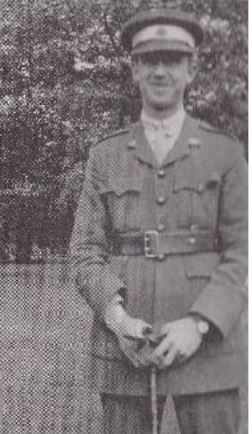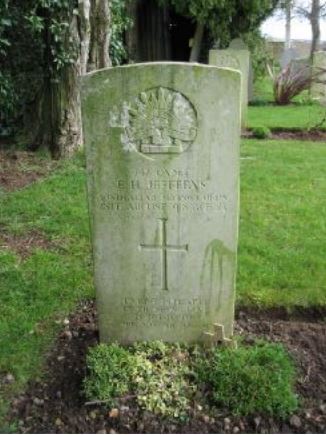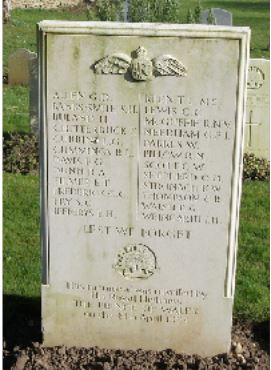6th Training Squadron, Australian Flying Corps

The 28th of August 1918 was a black day for Minchinhampton Aerodrome, as three of its pilots were killed in one accident.
Ernest Howard Jefferys was born in 1895 at Lithgow, New South Wales (NSW), the son of Peter and Rose Elizabeth Howard Jefferys, of Railway Station, Kuring-gai, NSW.
Prior to enlisting in the Army he was an electrician but had had some military training with the Senior Cadets in 1911-12. He enlisted at Sydney on 17 August 1914, age 19 and was posted to the 2nd Battalion Re-enforcements.
He left Sydney on 18 October 1914, aboard the troopship Suffolk and arrived in Egypt on 8 December. On 9 June 1915 he left Alexandria aboard the troopship Southland, to join the 2nd Infantry Battalion, 1st Australian Division at Gallipoli.
On 8 August he received a scalp wound and was treated at No 27 Field Ambulance and a casualty clearing station before being admitted to the 1st Australian Stationary Hospital at Mudros, on the island of Lemnos. The wound was sufficiently serious to warrant transfer to England on board the Hospital Ship Aquitania. He arrived in England on 28 September 1915 and was admitted to King George V Hospital, Stamford Street, London.
He returned to duty at the ANZAC Monte Video Camp at Weymouth on 28 January 1916, before leaving for Egypt on 25 March 1916, aboard the troopship Huntsbill, arriving in Alexandria on 5 April 1916. He remained at the Australian base at Tel-el-Kabir until June 1916 and was promoted to
Serjeant on 3 May.
From 3 July to 28 September 1916 he was back in England, undertaking a course at the School of Instruction for PT and Gymnastics at Aldershot, prior to a posting to 1st Australian Divisional Base Depot at Etaples, France on 19 November 1916. He rejoined the 2nd Infantry Battalion on 4 December 1916.
On 4 May 1917, during the Battle of Bullecourt, in the latter stages of the Arras Offensive, he suffered a gunshot wound to the shoulder and was treated at No 5 Field Ambulance and No 8 General Hospital, Rouen, before being sent from Le Havre to Plymouth on the Hospital Ship Panama and admission to 4th Southern General Hospital in Plymouth.
Upon discharge, on 20 June 1917, he was sent to the Australian Command Depot at Codford, and undertook a physical and bayonet training course at Aldershot between 6 August and 1 September.
Following his return to Codford he went absent without leave, from noon on 8 September to 1.45pm on the 10th. The reasons for absence are unknown but despite his pleading ‘not guilty’ at a District Court Martial, held on 18 September, a guilty verdict was passed and he was reduced to the rank of corporal and forfeited eleven days’ pay. Shortly after he was marked down for an overseas training battalion.
He escaped being sent overseas, probably thanks to putting in an application to be a wireless operator and was sent to 8th Training Battalion at Hurcott, Wiltshire for an aptitude test. He must have performed well as, on 18 January 1918, he was sent to a Royal Engineers Wireless Signals Depot at Fenny Stratford (now part of Milton Keynes). He stayed there for two months before, having volunteered for the newly formed Australian Flying Corps (AFC), he transferred to their Depot at Halton Camp, Wendover, Buckinghamshire.
According to Anzacs over England by David Goodland and Alan Vaughan (source of the photo at heading), ‘Jeffy’, as he was known, whilst in England had met Gertie Dowsett, a childhood sweetheart who, having volunteered as a VAD nurse, was in England.
On 12 April 1918 Corporal Jefferys was selected to undergo pilot instruction, which he undertook at No. 2 School of Military Aviation, Oxford and was appointed Corporal Cadet. Part of his training took place at the Royal Air Force (RAF) Armament School, Uxbridge, Middlesex and upon completion he was posted to 6th Training Squadron, AFC at Minchinhampton Aerodrome (later known as Aston Down).
He was considered a promising pupil and had flown for 10 hours 20 mins in an Avro 504 D6, under dual control, plus 1 hour 10 minutes solo. At about 6.35am on 28 August 1918, Cadet Jefferys, was required by his instructor to spend about 30 minutes practicing solo flying, to include vertical turns. The instructor observed him performing competently for about 15 minutes before undertaking other tasks. The weather was fair and visibility good.
Also in the air at the time, over Minchinhampton Aerodrome, was an Avro 504K (serial number D9282) from 5th Training Squadron, piloted by Second Lieutenant Roy Lytton, instructing Lieutenant Charles William Scott. Sometime between 7 and 7.30am, at a height of between 1000
to 1500 feet, the two aircraft were flying at right angles to one another, Jefferys heading north east and Cummings and Scott south east. Jeffreys aircraft turned left and its right wing collided with the right wing of the other machine: both aircraft fell to earth killing all occupants instantly. Cadet Jefferys suffered fractures to his skull, both legs and pelvis; he was 23 years old.
A Court of Enquiry believed that pilot error on Jefferys’ part was the cause but a subsequent Inquest decided that it was accidental death, in the case of the three individuals involved.
A joint burial service for the three men was held, with military honours, at Leighterton Church Cemetery on 31 August 1918 and they were buried alongside each other. CWGC headstones now mark their graves. Gertie Dowsett was one of the mourners. Cadet Jefferys is commemorated on the Berona, Victoria War Memorial.


Researched by Graham Adams 18 January 2018
